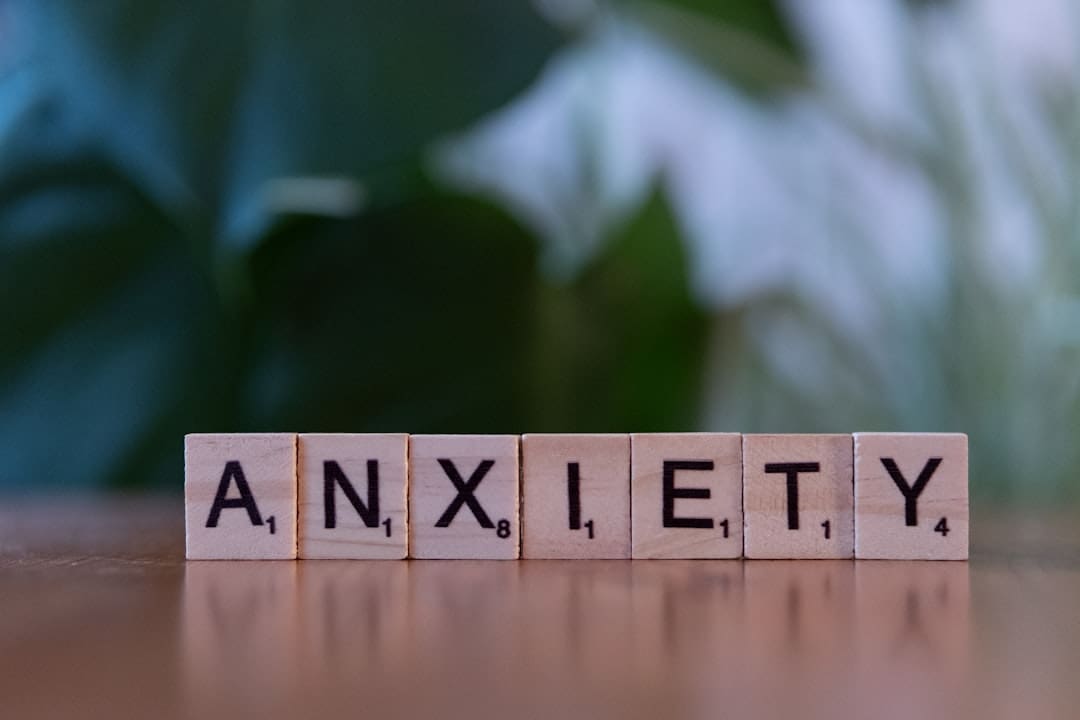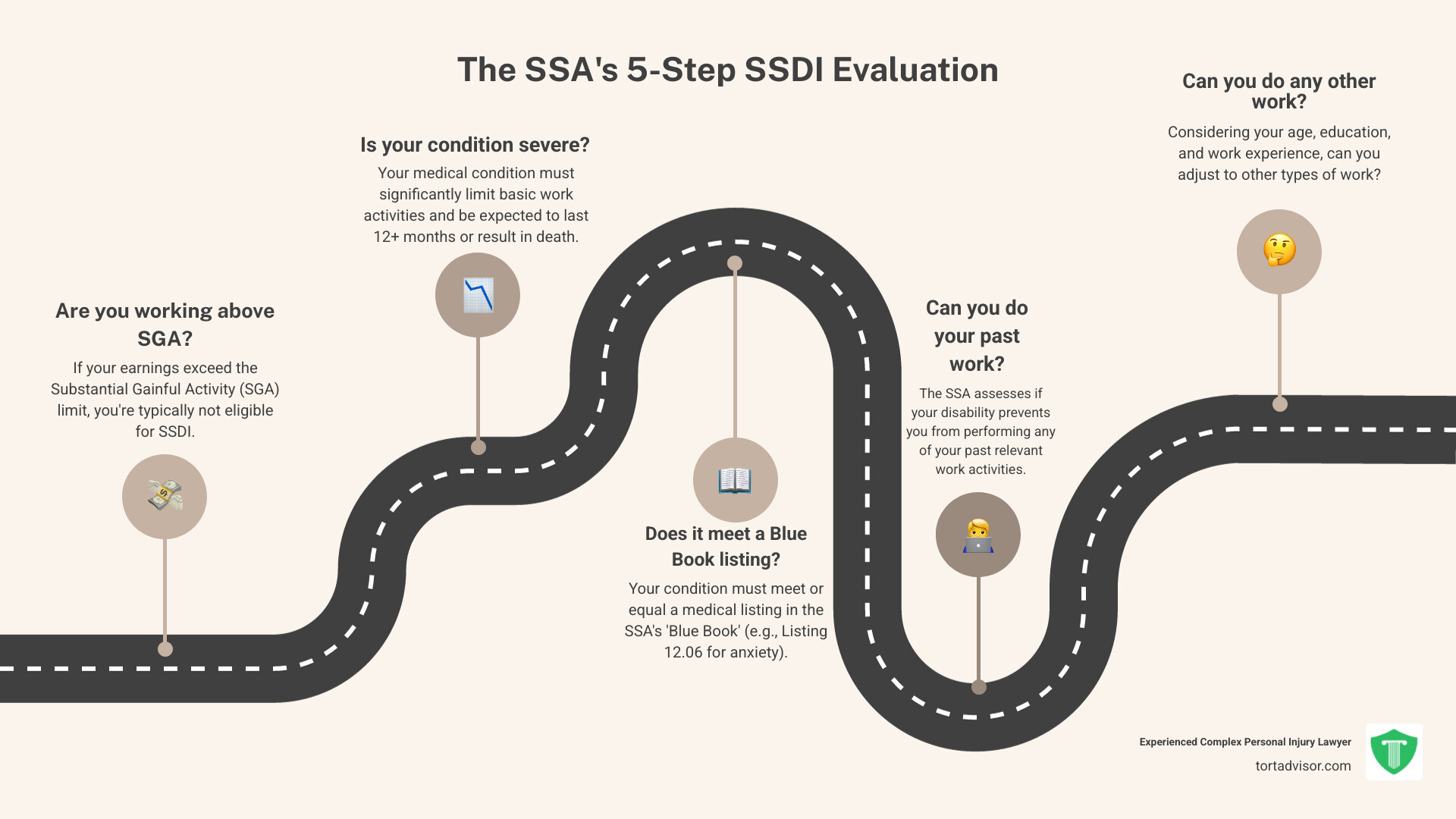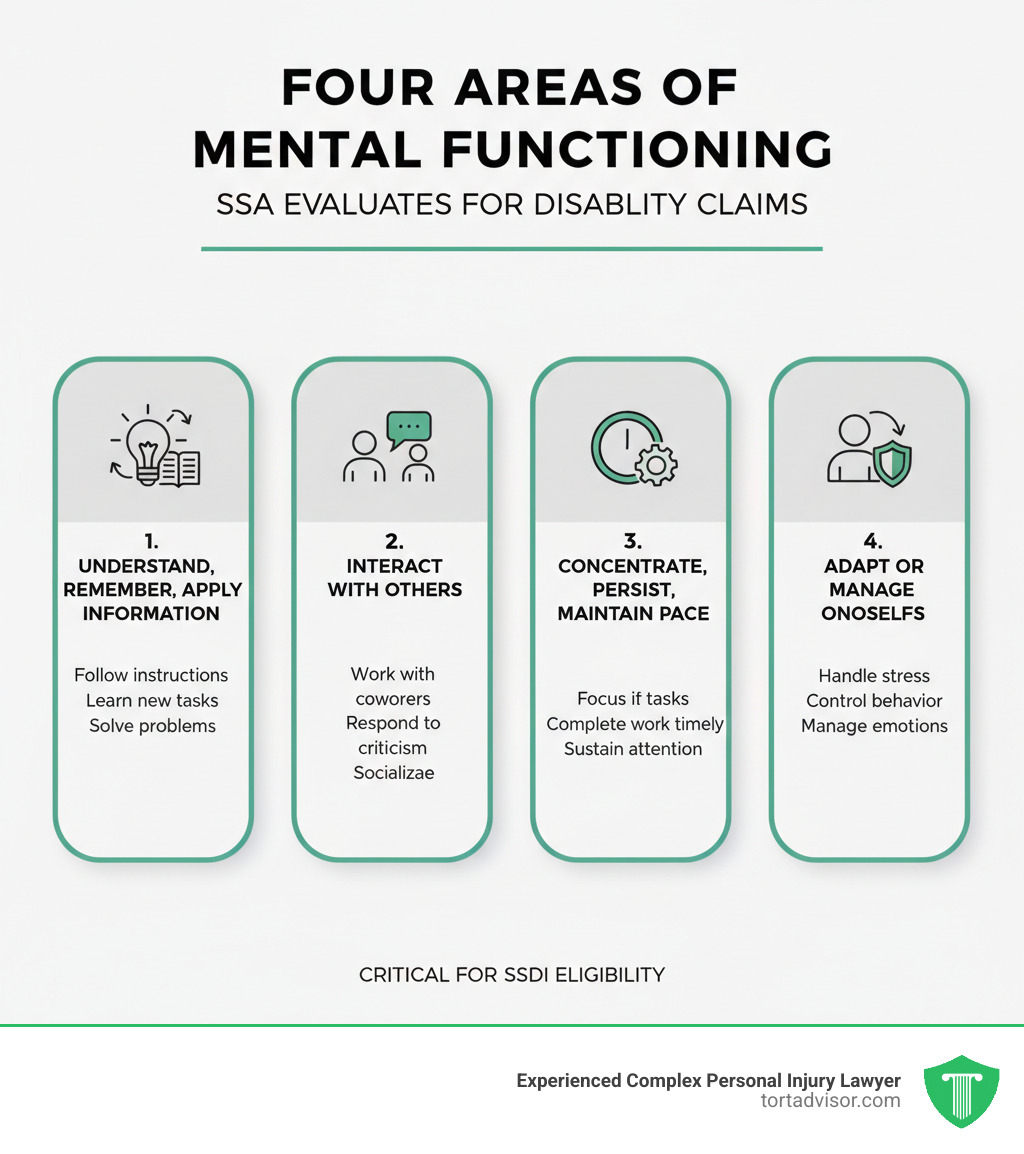


Understanding SSDI for Anxiety: Can Your Condition Qualify?
SSDI for anxiety can provide critical financial support if your anxiety disorder prevents you from working. Here’s what you need to know:
Quick Answer: Does Anxiety Qualify for SSDI?
- Yes, anxiety can qualify – The Social Security Administration (SSA) recognizes anxiety disorders as potentially disabling conditions.
- You must meet specific criteria – Your anxiety must be medically documented and severely limit your ability to function.
- Key requirements include:
- Medical evidence of a recognized anxiety disorder.
- Proof that your condition causes “marked” limitations in at least two areas of mental functioning OR one “extreme” limitation.
- Documentation showing your anxiety prevents substantial gainful activity (earning more than $1,550/month in 2024).
- Approval is challenging but possible – Only about 20-31% of initial applications are approved, but more than half succeed on appeal.
Living with disabling anxiety is overwhelming. According to the World Health Organization, anxiety disorders affect over 301 million people worldwide. Still, SSDI approval isn’t automatic. The SSA requires strong, consistent medical evidence and a clear showing of how your symptoms prevent full-time work. The initial review can take 6-9 months, and many first-time claims are denied due to documentation gaps.
This guide explains what the SSA looks for, the evidence that strengthens claims, and how to steer applications and appeals.
I’m Mason Arnao. While my primary expertise is in technology and digital marketing, I’ve deeply researched SSDI for anxiety to help people understand the rules and connect with the legal resources they need.
Understanding SSDI and Anxiety as a Qualifying Disability
Social Security Disability Insurance (SSDI) is an earned benefit funded by your payroll taxes. If a medical condition prevents you from engaging in Substantial Gainful Activity (SGA)—$1,550/month in 2024—and is expected to last at least 12 months, you may qualify. Eligibility also depends on having sufficient work credits (most adults need about 20 credits in the last 10 years).
The SSA recognizes severe mental disorders, including anxiety, as potentially disabling under the “Blue Book” Section 12.00 Mental Disorders – Adult.
Recognized Anxiety Disorders
A diagnosis alone isn’t enough; you must show severe, work-preventing functional limitations. Recognized disorders include:
- Generalized Anxiety Disorder (GAD): Persistent, excessive worry with symptoms like fatigue, poor concentration, and sleep disturbance.
- Panic Disorder: Recurrent panic attacks and fear of future attacks that disrupt normal activities and attendance.
- Social Anxiety Disorder: Debilitating fear of social interaction that impairs work with coworkers, supervisors, or the public.
- Obsessive-Compulsive Disorder (OCD): Time-consuming obsessions/compulsions that interfere with routine and task completion.
- Agoraphobia: Avoidance of places/situations (e.g., crowds, transit) that can make commuting or on-site work impossible.
- Post-Traumatic Stress Disorder (PTSD): Trauma-related symptoms like intrusive thoughts and hyperarousal that derail concentration and stability.
What matters most is how your condition limits work-related functioning, even with treatment.
The SSA’s Criteria for SSDI for Anxiety
When you apply for SSDI for anxiety, the SSA evaluates your claim under the mental-disorders listings, especially Listing 12.06 (Anxiety and Obsessive-Compulsive Disorders) found in the Blue Book.
Meeting the “Blue Book” Listing 12.06
You must meet Paragraph A and either Paragraph B or Paragraph C.
- Paragraph A (medical documentation)
- GAD with at least three: restlessness, fatigue, concentration problems, irritability, muscle tension, or sleep disturbance; or
- Panic disorder/agoraphobia with recurrent panic attacks and persistent worry/avoidance; or
- OCD with time-consuming obsessions/compulsions.
- Paragraph B (functional limitations)
- One “extreme” or two “marked” limitations in the areas below.
The SSA rates four areas: (1) understand/remember/apply information, (2) interact with others, (3) concentrate/persist/maintain pace, and (4) adapt/manage oneself.
- Marked = seriously limited ability to function independently, appropriately, effectively, and on a sustained basis.
- Extreme = inability to function in that area.
- Paragraph C (serious and persistent disorder)
- Medically documented for at least two years;
- Ongoing treatment/support that diminishes symptoms; and
- Only marginal adjustment, meaning minimal capacity to adapt to new demands or changes.
Building Your Case: Essential Documentation and Evidence
To win an SSDI for anxiety claim, present clear, consistent evidence showing how your symptoms prevent full-time work despite treatment.
Crucial Medical Evidence
- Medical records: Notes from primary care, psychiatrists, psychologists, and therapists detailing diagnosis, symptoms, course, and work-related limitations.
- Psychiatric/psychological evaluations: Mental status exams and testing that objectively document severity.
- Therapy notes: Ongoing records of frequency, triggers, and functional impacts.
- Medication history/side effects: Names, doses, changes, and impairing effects (e.g., fatigue, brain fog).
- Medical source statement: A treating provider’s opinion on specific work limitations carries significant weight. See why your doctor’s opinion matters.
- Hospitalizations: Any psychiatric admission strongly evidences severity.
Residual Functional Capacity (RFC)
If you don’t meet Listing 12.06, you can still qualify via a Medical-Vocational Allowance. A mental RFC describes what you can sustain (8 hours/day, 5 days/week): following instructions, maintaining pace, interacting with others, and handling stress/change. If your RFC shows you can’t sustain even simple, unskilled work, the SSA may find you disabled. The SSA considers how your daily activities reflect your limitations.
Non-Medical Evidence
- Third-party statements: Family/friends describing panic episodes, avoidance, and daily limits.
- Former employer statements: Attendance issues, conflicts, missed deadlines, failed accommodations.
- Symptom journal: Daily notes on anxiety severity, triggers, and functional fallout.
Navigating the SSDI Application and Appeals Process
Dealing with SSDI paperwork while managing anxiety is tough, but preparation helps. The SSA’s page on Preparing for SSA benefits can get you organized.
How to Apply for SSDI Benefits
Apply:
- Online via SSA.gov (work at your own pace),
- By phone (SSA toll-free), or
- In person at your local office.
Gather IDs, full medical provider list (names/addresses/dates), medications, therapies, and 15-year work history. Use the SSA’s official checklist. Initial decisions typically take 6–9 months. You may be asked for additional forms or a consultative exam—respond promptly.
What to Do If Your Denied Disability Claim is for Anxiety
Most initial claims are denied (about 20–31%), often for missing evidence. Many approvals happen on appeal. You have 60 days to appeal:
- Reconsideration: New examiner reviews your file; submit updated evidence.
- ALJ hearing: Present testimony and medical opinions; many claims win here.
- Appeals Council: Reviews for legal/procedural errors.
- Federal court: Final option.
See the SSA guide on appealing a decision from the SSA. Experienced disability attorneys can significantly improve outcomes.
Frequently Asked Questions about SSDI for Anxiety
Can I work at all while applying for or receiving SSDI for anxiety?
- While applying: If you earn above SGA ($1,550/month in 2024), SSA will likely deny your claim. Part-time work below SGA is scrutinized.
- While receiving SSDI: You can try a Trial Work Period (at least 9 months) without losing benefits, then an Extended Period of Eligibility where benefits continue if earnings stay below SGA. Report all work promptly. See Working While Disabled: How We Can Help.
How much is a disability check for anxiety?
- SSDI: Based on your lifetime covered earnings. Many receive around $1,200–$1,500/month; the 2024 maximum is $3,822.
- SSI: Needs-based. The 2024 federal maximum is $943/month for an individual (reduced by certain income).
| Benefit Type | Calculation Basis | Average/Maximum Monthly Payment |
|---|---|---|
| SSDI | Based on your work history and Social Security taxes paid | Average: $1,200-$1,500; Maximum: $3,822 |
| SSI | Based on financial need (income and resources) | Maximum: $943 (may be reduced based on other income) |
What are my chances of getting approved for anxiety?
Initial approvals are about 20–31%. More than half of applicants who appeal—especially at an ALJ hearing—ultimately win. Your odds improve with:
- Robust medical evidence (psychiatry/therapy records),
- Third-party corroboration, and
- Help from an experienced disability attorney.
At Tort Advisor, we connect people with trusted legal help for your SSDI Lawsuit—lawyers with proven results in anxiety-based claims.
Introduction
Understanding SSDI for Anxiety: Can Your Condition Qualify?
SSDI for anxiety can provide benefits when medically documented symptoms prevent full-time work.
- Yes, anxiety can qualify. The SSA recognizes anxiety disorders as potentially disabling.
- You must show severity. Evidence must prove marked limits in two mental-function areas or an extreme limit in one, and inability to perform substantial gainful activity (over $1,550/month in 2024).
- Approvals often happen on appeal. Only ~20–31% are approved initially; more than half succeed later.
The World Health Organization notes anxiety disorders are widespread, but SSDI decisions turn on evidence—not diagnosis alone.
I’m Mason Arnao, and I’ve researched SSDI for anxiety to help people understand the rules and find qualified legal support.
Understanding SSDI and Anxiety as a Qualifying Disability
SSDI is an earned insurance benefit for workers who become disabled. You typically need recent work credits and must be unable to engage in SGA ($1,550/month in 2024) for at least 12 months.
Anxiety disorders can qualify under the SSA’s Blue Book Section 12.00 Mental Disorders – Adult.
Recognized Anxiety Disorders
- Generalized Anxiety Disorder (GAD)
- Panic Disorder
- Social Anxiety Disorder
- Obsessive-Compulsive Disorder (OCD)
- Agoraphobia
- Post-Traumatic Stress Disorder (PTSD)
The key is documented functional impairment, despite treatment.
The SSA’s Criteria for SSDI for Anxiety
SSA uses Listing 12.06 to evaluate anxiety and OCD disorders. You must meet Paragraph A (diagnosis/symptoms) and either Paragraph B (marked/extreme functional limits) or Paragraph C (serious and persistent disorder with marginal adjustment). See the Blue Book.
The Four Areas of Mental Functioning the SSA Evaluates
- Understand, or apply information
- Interact with others
- Concentrate, persist, or maintain pace
- Adapt or manage oneself
Marked limits in two areas or an extreme limit in one can meet the listing.
Building Your Case: Essential Documentation and Evidence
Success hinges on thorough, consistent evidence.
Medical Evidence
- Complete treatment records (PCP, psychiatry, psychology, therapy)
- Mental status exams/psych testing
- Therapy notes tracking symptoms and function
- Medication history and side effects
- Treating provider medical source statement: work-related limits; see why a treating opinion matters
- Hospitalizations (if any)
RFC and Work Capacity
A mental RFC shows what you can sustain (8 hours/day, 5 days/week). If even simple, unskilled work isn’t sustainable, SSA can approve via a Medical-Vocational Allowance. SSA also looks at daily activities as evidence.
Non-Medical Evidence
- Third-party statements (family/friends)
- Former employer notes (attendance, conflicts)
- Symptom journals/logs
Navigating the SSDI Application and Appeals Process
Applying while anxious is hard—structure helps. See SSA’s page on Preparing for SSA benefits.
How to Apply for SSDI Benefits
- Apply online, by phone, or in person.
- Use the SSA’s checklist to gather IDs, provider contacts/dates, meds, therapy, and 15-year work history.
- Initial review: typically 6–9 months. Respond quickly to SSA requests and consultative exams.
What to Do If Your Denied Disability Claim is for Anxiety
- Appeal within 60 days.
1) Reconsideration; 2) ALJ hearing (many approvals here); 3) Appeals Council; 4) Federal court. - Add updated medical opinions and functional detail. Learn more about appealing a decision from the SSA.
- Experienced counsel improves outcomes.
Frequently Asked Questions about SSDI for Anxiety
Can I work at all while applying for or receiving SSDI for anxiety?
- Applying: Earnings over SGA ($1,550/month in 2024) usually mean denial. Part-time under SGA is scrutinized.
- Receiving SSDI: Use the Trial Work Period and Extended Period of Eligibility; always report work. Details: Working While Disabled: How We Can Help.
How much is a disability check for anxiety?
- SSDI: Based on your covered earnings; many receive about $1,200–$1,500/month; 2024 max is $3,822.
- SSI: Needs-based; 2024 federal max is $943/month for an individual.
What are my chances of getting approved for anxiety?
Initial approvals: ~20–31%. Over half win on appeal, especially at ALJ hearings—strong evidence and legal representation help.
Conclusion
Securing SSDI for anxiety is possible with strong documentation and persistence. If you’re denied, appeal—many claims win at the hearing stage.
Tort Advisor connects you with proven disability attorneys who know how to build winning cases for anxiety-based claims.
Find trusted legal help for your SSDI claim today.
Free Confidential Case Evaluation
Complete the short form below to get an immediate FREE case review with an expert in your specific claim. Don't wait, your case could be time sensitive to file a claim.
Related Posts
Did a North Dakota product cause harm? Understand product liability, your rights, and how to take action for defects.
Get justice for clergy abuse. Find an expert Priest abuse lawyer to navigate complex laws and hold institutions accountable.
Diagnosed with meningioma after Depo-Provera? Understand potential Depo-Provera lawsuit settlements, risks, & how to claim compensation.
Uncover the truth about uber sexual assault cases. Learn about the alarming scale, Uber's accountability, and legal options for justice.
Facing wildfire losses? Discover the best wildfire lawsuit attorneys in California to fight for your full recovery and justice.
Exposed to Roundup & diagnosed with NHL? Discover how to sue Monsanto, understand eligibility, & seek compensation. Your guide to justice.











